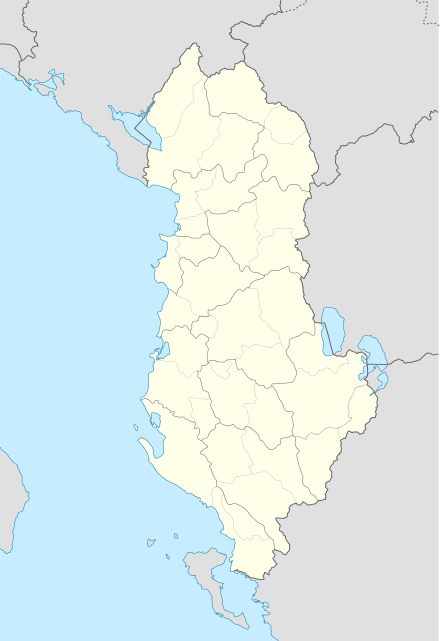Rrash-Kullaj
| Rrash-Kullaj | |
|---|---|
| Village | |
 Rrash-Kullaj | |
| Coordinates: 42°9′4″N 19°31′45″E / 42.15111°N 19.52917°ECoordinates: 42°9′4″N 19°31′45″E / 42.15111°N 19.52917°E | |
| Country |
|
| County | Shkodër |
| Municipality(s) | Malësi e Madhe |
| Time zone | UTC+1 (CET) |
| • Summer (DST) | UTC+2 (CEST) |
Rrash-Kullaj (also known as Kulla të Rrashit and Kulla të Boksit) is a settlement in the former Gruemirë municipality, Shkodër County, northern Albania.[1] At the 2015 local government reform it became part of the municipality Malësi e Madhe.[2]
History
"Rrash-Kullaj" is the merger of the villages of Rrash and Kulla. These were mentioned for the first time in a Venetian cadastral document from 1416.[3]
During the first World War occupying Austro-Hungarian forces conducted a census (1916-1918) of parts of Albania they held such as the wider Shkodër region and of Rrash-Kullaj they recorded 10 households, 122 people: 122 Albanians; 122 Orthodox.[4] Though linguists Klaus Steinke and Xhelal Ylli consider the overall census results regarding the Shkodër area to be the first instance of reliable information on the number of households and inhabitants as well as the ethnic and religious composition of these places, they note that the data for Rrash-Kullaj is somewhat unclear as the inhabitants are referred to as both Albanians and Orthodox.[4]
The villages of Rrash and Kulla were inhabited by Serbs–Montenegrins until World War II, and are thus historically part of the Vraka region. In 1933, the following brotherhoods inhabited Rrash (Raš): Roganović (5 houses), Bjelanović-Marković (2 houses), Krstović (2 houses), Uskoković (2 houses), Racković (1 house), Krkotić (1 house), Malisori (Albanians, 2 houses); a total of 13 Vračani (Serb-Montenegrin) houses which have all left the village. The following brotherhoods inhabited Kulla (Kule): Rešetar (6 houses), Bašanović (3 houses), Milogorić (1 house), Malisori (1 house); a total of 13 Vračani houses which have all left the village.[3]
Culture
- Church of St. John of Rrash (св. Јован рашки)
References
- ↑ "Location of Rrash-Kullaj". Retrieved 26 August 2010.
- ↑ Law nr. 115/2014 Archived 2015-09-24 at the Wayback Machine.
- 1 2 Благоје В. Марковић (1990). "Врака и Врачани".
Још од катастра 1416., без промјене до 1933. помињу се села: Раш и Куле [...] Јована рашког атарима села Раша и Пула око којих je и по броју и по врсти остало највише споменичких остатака: зидина, зараслих кућних темеља, земљаних хумки "главица", гробаља на неколико мјеста, стародревних стабала дрвећа. На једном од великих млинарских брестова атара села Куле Црногорци су 1912. поставили осматрачницу погледа на штојски фронт и ка Скадру.[14] О густини насељености положају ширем смислу, у старих Врачана забиљежио сам предање: "От старога Громира ("Громир кећ") преко Раша и св. Јована до Дришта (Дриваст) могла je мачка с куће на кућу да мине а да земљу не такне". [...] Арнаутско село "Раш Мали" - топоним, спуштен je на мјесто врачкога Раша, те, сада, древни Раш се назива "Раши вогељ". По неким вијестима наш Раш je срушен и планиран изнова, а св. Јован "Црквина", служи у друге сврхе. [...] Село Раш [...] Село Куле
- 1 2 Steinke, Klaus; Ylli, Xhelal (2013). Die slavischen Minderheiten in Albanien (SMA). 4. Teil: Vraka - Borakaj. Munich: Verlag Otto Sagner. ISBN 9783866883635. p. 17. "Die ersten verlasslichen Angaben zur Häuser- und Einwohnerzahl sowie zur ethnischen und religiösen Zusammensetzung der Orte macht SEINER (1922: 29, 32). Nur zwei Angaben sind unklar, nämlich für Boriç und Rrash Kullaj, weil die Einwohner dort gleichzeitig als Albaner und Orthodoxe bezeichnet werden.... Hauser H, Einwohner E, Albaner A, Serbokroaten Skr, Katholiken K, Orthodoxe O, Muslime M.... Rrash-Kullaj[24] 10 H 122 E, 122 A, 122 O; [footnote 24] Als Kullat e Rrashit angegeben.
